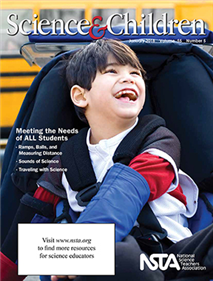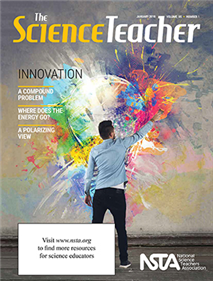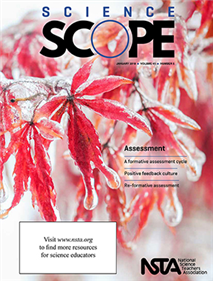All Resources
Journal Article
A STEAM Lesson for fifth graders incorporates the Engineering Design Process....
Journal Article
Using the Universal Design for Learning framework to support all learners...
Journal Article
Accommodating students who are deaf or hard of hearing in a unit on sound...
Journal Article
Ramps, Balls, and Measuring Distance—For All
Ensuring meaningful access to science curriculum for students with physical disabilities...
Journal Article
Working with orientation and mobility specialists to make science accessible for kindergarten students with visual impairments...
Journal Article
Editor's Note: Removing Barriers
Science and Children’s editor shares thoughts regarding the current issue....
Journal Article
The Early Years: An Activity for Every Child
This column discusses resources and science topics related to students in grades preK to 2. This month’s issue has students developing a seed-planting activity that allows all children to actively participate and document their understanding of see...
Journal Article
Formative Assessment Probes: Uncovering Representations of the Water Cycle
This column focuses on promoting learning through assessment. This month’s issue explores the effect of representations on children’s thinking about evaporation and the water cycle....
Journal Article
Teaching Through Trade Books: Energy Explorations
This column includes activities inspired by children’s literature. Young students should understand that sunlight warms the Earth and be able to make decisions about maximizing energy by using different types of materials and locations to keep obje...
Journal Article
The Poetry of Science: Seeing Clearly
Building literacy in playful, meaningful ways to learn about vision correction....
Journal Article
Science 101: Why Do Computers Keep Getting Smaller and Smaller?
This column provides background science information for elementary teachers. This month’s issue discusses the history of why computers have reduced in size....
Journal Article
Science 102: A Bunny of a Different Color
This column shares exercises to challenge content knowledge. This month's issue presents a new challenge and answers the Ghostly Images challenge from last month....
Journal Article
Engineering Encounters: Identifying an Engineering Design Problem
This column presents ideas and techniques to enhance your science teaching. Engineering a pancake recipe gives fifth graders a taste of chemistry in everyday life....
Journal Article
Teaching Teachers: The Scientist Showcase
This column enhances the repertoire of preservice and inservice teachers. A tool for highlighting diverse scientists in the elementary classroom....
Journal Article
Methods and Strategies: Teaching the Nature of Science to Elementary Students
This column provides ideas and techniques to enhance your science teaching. This month’s issue shares activities so that elementary students can learn about Nature of Science. When effectively integrated into inquiry investigations through proper s...
Journal Article
Using evidence-based reasoning to explore relationships between energy and motion....
Journal Article
An unconventional use of microscopes for teaching high school geology and physics....
Journal Article
Build an Interactive Word Wall
Connecting scientific concepts with academic vocabulary....
Journal Article
Editor’s Corner: New Year, New Look
The Science Teacher’s editor shares thoughts on the current issue....
Journal Article
The Green Room: The Top 5 Environmental Stories of 2017
This column focuses on making your teaching more environmentally friendly. This month’s issue highlights top environmental news....
Journal Article
Focus on Physics: Our Molecular Selves
This column helps teachers build an understanding of physical principles. This month's issue discusses atoms and molecules....
Journal Article
Career of the Month: Robotics Engineer
This column shares interviews with professionals using science in the workplace. This month’s issue describes Kevin Dowling's career path to becoming a Robotics Engineer....
Journal Article
Right to the Source: Invention vs. Innovation
Exploring science and history with the Library of Congress. This month's issue discusses the content of photographs of Thomas Edison and Emile Berliner....
Journal Article
Create open-ended prompts that integrate prior knowledge....
Journal Article
Creating a Positive Feedback Culture: Eight Practical Principles to Improve Students’ Learning
Learn how to elicit evidence of student learning, provide effective feedback, and extend student learning beyond the assessment....
Journal Article
Use a real-world scenario to engage in the scientific practice of collecting, analyzing, graphing, and interpreting data....
Journal Article
Integrating Technology: Bringing Science to Life
This column shares how teachers use technology for assessment, student learning, or classroom management. Using social learning to make real-world connections in science....
Journal Article
This column provides how-to strategies and practical advice for the science teacher. The CERR framework helps students synthesize science investigations, data analysis, and scientific concepts by having them focus on four elements: Claim, Evidence, R...
Journal Article
From the Editor’s Desk: Engaging Students in Learning Through Assessment
Science Scope’s editor shares thoughts regarding the current issue....
Journal Article
Commentary: Installing Glass Walls and Doors in the Science Classroom
An opinion piece about a science teacher team framework for improving student achievement....
Journal Article
Citizen Science: Birds, Binoculars, and Biodiversity
This column highlights formal and informal science research projects that students can join and contribute to by gathering and sharing data. Count birds and contribute to citizen science with the Great Backyard Bird Count....
Journal Article
Disequilibrium: Why Is Regular Soda Denser Than Diet Soda?
This column shows how to use discrepant events to confront misconceptions. This month’s discrepant event helps students visualize the difference between the densities of diet and regular soda and learn about the nutritional differences between the ...





